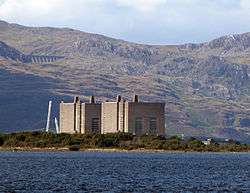Trawsfynydd nuclear power station
| Trawsfynydd nuclear power station | |
|---|---|
 | |
| Country | Wales, United Kingdom |
| Location | Trawsfynydd, Gwynedd |
| Coordinates | 52°55′29.51″N 3°56′54.38″W / 52.9248639°N 3.9484389°WCoordinates: 52°55′29.51″N 3°56′54.38″W / 52.9248639°N 3.9484389°W |
| Status | Closed |
| Construction began | 1959 |
| Commission date | 1965 |
| Decommission date | 1991 |
| Construction cost | £103 million |
| Owner(s) | Nuclear Decommissioning Authority |
| Operator(s) | Magnox Ltd |
| Nuclear power station | |
| Reactor type | Magnox |
| Reactor supplier | Atomic Power Constructions |
| Power generation | |
| Units decommissioned | 2 x 235 MW |
Trawsfynydd nuclear power station is a former Magnox power station situated in Snowdonia National Park in Gwynedd, Wales. The plant, which became operational in 1965, was the only nuclear power station in the UK to be not built on the coast (cooling water was taken from the man-made reservoir, Llyn Trawsfynydd). It was closed in 1991. Work to completely decommission the site is expected to take almost 100 years.[1]
History
The power station, which takes its name from the nearby village of Trawsfynydd, was designed by Basil Spence. The construction, which was undertaken by a consortium involving Crompton Parkinson, International Combustion, Fairey Engineering and Richardsons Westgarth, and known as the Atomic Power Constructions (APC),[2] began in July 1959, and both of the reactors were in operation by March 1965, with the station opening fully in October 1968, at a cost of £103 million.[3] It had two Magnox reactors producing 470 megawatts (MW) in total.[3] The reactors were supplied by APC and the turbines by Richardsons Westgarth.[3] The civil engineering work was undertaken by Holland, Hannen & Cubitts[4] and Trollope & Colls.[5] The architectural consultant for the buildings was Sir Basil Spence and the landscape architect was Sylvia Crowe.[6]
Nuclear flasks were transported to Trawsfynydd on a section of the former Bala to Blaenau Ffestiniog railway that had been closed in January 1961. A single track was restored northwards with an entirely new line through the centre of Blaenau Ffestiniog that connected to the Conwy Valley branch. In 1963-4 a "Goliath" gantry crane was installed over sidings about 1⁄2 mi (0.80 km) east of the power station.[7][8][9][10] Beginning on 20 April 1964, nuclear flasks could be transported by rail between destinations such as Sellafield in Cumbria. The last regular departure was on 8 August 1995.[11] The last train to carry nuclear material from Trawsfynydd left on 22 April 1997 hauled by EWS Loco 37426.[12] The line was subsequently mothballed.[13] In 2016 enthusiasts, who want to create a heritage railway, began clearing vegetation along the route.[14]
Decommissioning
Trawsfynydd was shut down in 1991. The Nuclear Decommissioning Authority has the responsibility of decommissioning the site. The work is expected to last decades.[15]
Beginning in 1993, the highly-radioactive spent fuel rods were removed from both Magnox reactors and sent by rail to Sellafield. This was completed in 1997. Intermediate level waste - such as on the walls of the cooling ponds or pipes - have been carefully removed using robots over the next decades. Contaminated material is stored in a specially-designed building on the site.[15] It will eventually be removed for deep burial in the 2040s. Between 2020 and 2026, the top parts of the two reactor buildings will be partially demolished to reduce their height.[16] But the steel reactor cores - that housed the fuel rods - will not be removed because they are still far too radioactive. The final clearance of the site is scheduled to begin in 2071.[16] By 2083 the area is expected to have been restored to its pre-nuclear state; 124 years after construction started and 92 years after the closure of Trawsfynydd power station.[1]
See also
Citations
- References
- 1 2 "So just how do you decommission a nuclear power station?". www.walesonline.co.uk. 30 December 2015.
The plans call for the waste to be moved from Trawsfynydd in the 2040s.
- ↑ The UK Magnox and AGR Power Station Projects
- 1 2 3 Nuclear Power Plants in the UK - Scotland and Wales Archived 2009-07-19 at the Portuguese Web Archive
- ↑ An historical survey of Cubitts, from the Company's inception in 1810 to the present day Page 25, Cubitts, 1975
- ↑ Trollope & Colls at the National Archives
- ↑ Site record for Trawsfynydd on RCAHMS index for Sir Basil Spence archive
- ↑ The siding and Goliath, via 2D53
- ↑ Mitchell & Smith 2010, Photo 28.
- ↑ Southern 1995, p. 71.
- ↑ A flask being loaded onto a railway wagon, via flickr
- ↑ Three flasks passing Blaenau on 8 August 1995, via flickr
- ↑ Mitchell & Smith 2010, Photo 66.
- ↑ "Inquiry into radioactivity scare". The Independent. 22 April 1997. Retrieved 9 August 2016.
- ↑ "Clearance work on disused Trawsfynydd railway line to start". BBC NEWS. 21 September 2016.
- 1 2 "How do you close a nuclear power station?". BBC. 28 October 2013. Retrieved 29 July 2016.
- 1 2 "So just how do you decommission a nuclear power station?". Wales Online. 30 December 2015. Retrieved 19 June 2017.
- Bibliography
- Mitchell, Vic; Smith, Keith (2010). Bala to Llandudno: Featuring Blaenau Ffestiniog. Midhurst, West Sussex: Middleton Press (MD). ISBN 978 1 906008 87 1.
- Southern, D. W. (1995). Bala Junction to Blaenau Ffestiniog (Scenes from the Past, Railways of North Wales, No. 25). Stockport: Foxline Publishing. ISBN 1 8701 19 34 7.
External links
- Nuclear Decommissioning Authority site (Trawsfynydd page)
- Trawsfynydd , Nuclear Engineering International wall chart, January 1961
- Some photos of Trawsfynydd power station
- Aerial views of the power station, via The People's Collection